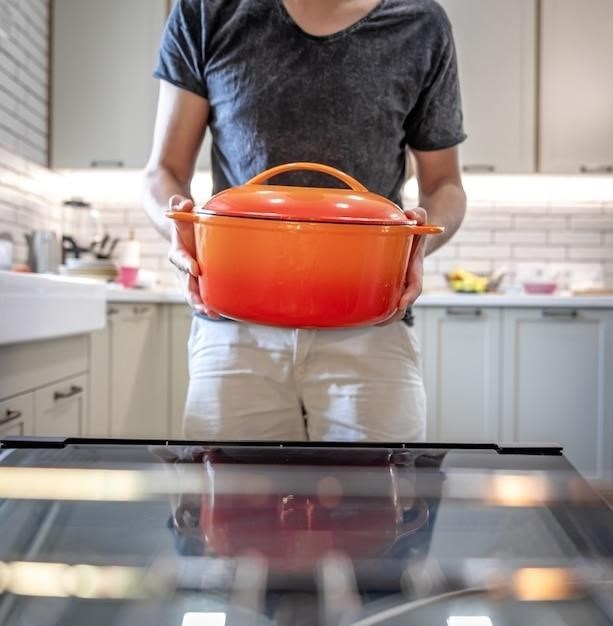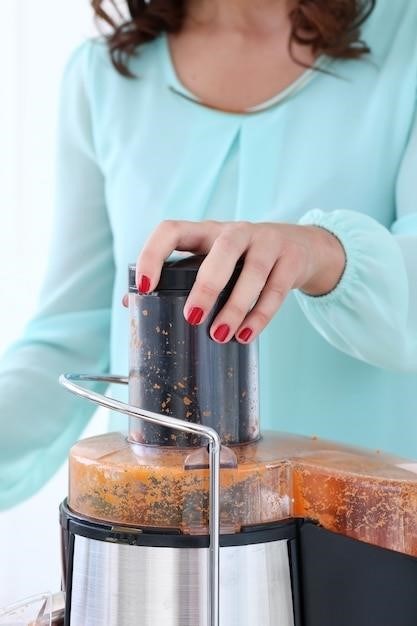Mirro 22 Qt Pressure Canner Manuals⁚ A Comprehensive Guide
This guide explores various Mirro 22 Qt pressure canner manuals‚ covering identification‚ dating‚ model numbers‚ specifications‚ and troubleshooting. Locate original manuals‚ understand safety features‚ and find replacement parts information. Learn about proper usage‚ safety precautions‚ and helpful recipes and tips for successful pressure canning.
Finding Original Mirro Manuals
Locating original Mirro 22 Qt pressure canner manuals can be a rewarding yet challenging endeavor. Several avenues exist for your search. Online marketplaces like eBay and Etsy often feature vintage manuals; diligent searching may uncover a suitable match. Check online forums and communities dedicated to canning and preserving; enthusiasts may have scanned copies or know of sources. Contacting Mirro directly (if they still offer support) or browsing their website for archived documents may also yield positive results. Consider contacting antique kitchen appliance dealers or collectors; their networks might lead to a manual. Remember to carefully examine the descriptions and photos to ensure compatibility with your specific Mirro 22 Qt model before purchasing any manual.
Dating and Identifying Different Mirro Manuals
Pinpointing the exact date of a Mirro 22 Qt pressure canner manual can be tricky‚ as not all manuals include a clear publication date. However‚ several clues can help determine the approximate age. Look for copyright information on the manual’s title page or copyright page; this information usually indicates the year of publication. Examine the manual’s design and layout; changes in typography‚ illustrations‚ and overall style can reflect different eras. Compare your manual to online images of known-dated Mirro manuals; similarities in design or content may help establish a timeline. Check for model numbers mentioned within the manual; cross-referencing these numbers with online databases or Mirro’s website (if available) can offer clues about the manual’s release period. Consider the paper quality and printing techniques; older manuals might exhibit characteristics like yellowish paper or less refined printing compared to newer ones; Pay attention to any handwritten notes or markings on the manual‚ as these might provide valuable historical context.
Mirro 22 Qt Pressure Canner Model Numbers and Specifications
Mirro 22-quart pressure canners often have model numbers that incorporate letters and numbers‚ such as the example “92122A.” These numbers aren’t always consistently displayed; some manuals might only list a general model type rather than a specific alphanumeric code. The model number usually appears on a label attached to the canner itself or printed directly on the canner’s body; Specifications for Mirro 22-quart pressure canners typically include details about the canner’s capacity (22 quarts)‚ material (usually aluminum)‚ and pressure regulation system. The manual should specify the operating pressure range and any safety features incorporated into the design. Dimensions (height‚ width‚ depth)‚ weight‚ and any included accessories (like racks or a pressure gauge) are additional specifications commonly found within the accompanying documentation. Finding these details will require close examination of your specific manual and the canner itself for markings that denote the exact model and its attributes. Always refer to your manual for precise information relevant to your canner’s model.

Troubleshooting and Repair
This section addresses common Mirro 22-quart pressure canner issues‚ guiding you through troubleshooting steps and providing information on locating and ordering replacement parts‚ ensuring safe and efficient operation.
Locating and Ordering Replacement Parts
Finding replacement parts for your Mirro 22-quart pressure canner might require a multifaceted approach. First‚ check online retailers specializing in kitchen appliance parts. Many sites offer diagrams and part lists‚ making identification easier. Sites like Amazon or eBay may have individual parts or complete kits available from various sellers. Remember to cross-reference your canner’s model number (often found on a sticker on the unit) to ensure compatibility.
If online searches prove fruitless‚ consider contacting Mirro directly‚ though the company’s current status and customer support availability should be researched beforehand. Alternatively‚ search for authorized Mirro repair centers or contact local appliance repair shops. They might have access to parts or know reliable sources. Lastly‚ forums and online communities dedicated to canning and pressure cookers can be invaluable resources. Experienced users often share tips on finding obscure parts or alternative solutions.
When ordering‚ meticulously note the part number to avoid errors. Compare prices and seller reviews before committing to a purchase. Always ensure that the replacement part is genuinely compatible with your Mirro 22-quart pressure canner model to maintain safety and performance.
Understanding Mirro Pressure Canner Safety Features
Mirro pressure canners‚ including the 22-quart model‚ incorporate several crucial safety mechanisms. A pressure regulator or gauge monitors internal pressure‚ preventing dangerous over-pressurization. A vent pipe or weight releases excess steam‚ maintaining safe pressure levels. Proper sealing is essential; ensure the lid is correctly positioned and locked to create an airtight environment. Never attempt to force the lid or operate a malfunctioning canner.
The canner’s construction plays a significant role in safety. Heavy-gauge aluminum or stainless steel construction is designed to withstand high pressure. Always inspect the canner before each use for any signs of damage‚ such as dents‚ cracks‚ or warping. Never use a damaged canner; replace it immediately. Understanding the pressure release methods is crucial. Familiarize yourself with how to safely release pressure after cooking‚ either naturally or using a quick-release mechanism‚ following the instructions in your specific Mirro manual.
Regular maintenance is vital for safety. Clean the canner thoroughly after each use‚ paying close attention to the seals and gaskets. Replace worn or damaged seals promptly. Always follow the manufacturer’s instructions for operation and maintenance to ensure your Mirro pressure canner functions safely and efficiently. Ignoring safety precautions can lead to serious accidents.

Using Your Mirro 22 Qt Pressure Canner
Mastering your Mirro 22-quart pressure canner involves understanding its features‚ following instructions precisely‚ and adhering strictly to safety guidelines for successful and safe home canning.
Following Instructions and Safety Precautions
Before using your Mirro 22 Qt pressure canner‚ meticulously read the instruction manual. Familiarize yourself with all safety features‚ including the pressure regulator and vent pipe. Ensure the vent pipe is clear of obstructions before each use‚ as per the safety advice found in many online sources. Properly seating the lid is crucial; a secure seal prevents accidents and ensures even pressure distribution. Always use the correct amount of water‚ as specified in the manual‚ to prevent damage to the canner and ensure efficient operation. Never attempt to force the lid; a proper seal should be achieved with minimal effort. Understanding pressure levels is essential; monitor the gauge closely during operation. Never exceed the recommended maximum pressure. Consult the manual for specifics on processing times for different foods. Remember to allow for a natural pressure release after cooking before opening the lid to prevent burns from escaping steam. Following these steps ensures safe and effective pressure canning.
Recipes and Usage Tips
Your Mirro 22 Qt pressure canner opens a world of delicious preserved foods. Start with simple recipes like vegetable soup or canned tomatoes‚ gradually increasing complexity. Many online resources offer tested recipes specifically designed for pressure canners. Remember to adjust processing times based on altitude; higher altitudes require longer processing times. Properly prepare your ingredients before canning; clean‚ peel‚ and cut vegetables to consistent sizes for even cooking. Use appropriate jars and lids; ensure they are in good condition and free from chips or cracks. Follow the recommended headspace guidelines to allow for expansion during processing. Experiment with different seasonings and herbs to create unique flavors. Properly seal jars after processing to maintain freshness and prevent spoilage. Always check for proper sealing after cooling. Store canned goods in a cool‚ dark‚ and dry place. Enjoy the fruits (and vegetables!) of your labor‚ knowing your home-canned food is safe and delicious. With practice and these tips‚ you’ll master the art of pressure canning.
Leave a Reply
You must be logged in to post a comment.